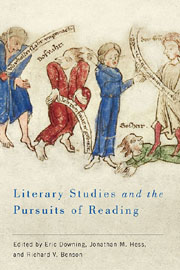Book contents
- Frontmatter
- Contents
- List of Illustrations
- Introduction
- Part I Medieval and Early Modern Practices of Reading
- Part II Reading, Secularization, and Transcendence in the Long Nineteenth Century
- Part III Theories and Practices of Reading in the Twentieth Century and Beyond
- 9 Magic Reading
- 10 “Anything One Wants”: Kafka and Women, Again
- 11 Reading on the Edge of Oblivion: Virgil and Virgule in Coetzee's Age of Iron
- Part IV Postscript: The Ends of Reading
- Works Cited
- Notes on the Contributors
- Index
9 - Magic Reading
from Part III - Theories and Practices of Reading in the Twentieth Century and Beyond
Published online by Cambridge University Press: 05 February 2013
- Frontmatter
- Contents
- List of Illustrations
- Introduction
- Part I Medieval and Early Modern Practices of Reading
- Part II Reading, Secularization, and Transcendence in the Long Nineteenth Century
- Part III Theories and Practices of Reading in the Twentieth Century and Beyond
- 9 Magic Reading
- 10 “Anything One Wants”: Kafka and Women, Again
- 11 Reading on the Edge of Oblivion: Virgil and Virgule in Coetzee's Age of Iron
- Part IV Postscript: The Ends of Reading
- Works Cited
- Notes on the Contributors
- Index
Summary
Was nie geschrieben wurde, lesen.
—Walter BenjaminNear the end of his 1929 essay on surrealism, and in the context of serious discussions of the occult, Walter Benjamin declares that “the most passionate investigation of telepathic phenomenon will not teach us half as much about reading (which is an eminently telepathic phenomenon) as the profane illumination of reading will teach us about telepathic phenomena” (GS, 307 / SW, 216). The suggested link here between practices of reading and the occult is a profound one, both historically and for Benjamin's own time and work, and not just in terms of telepathy. Some of the earliest practices of reading were not of letters, words, or books, but of stars, entrails, and birds; and these practices had a significant impact on the way literature was read and understood in the ancient world. And the relations between such ancient magic and the reading of literature were still (or again) of crucial importance to the modernists of the early twentieth century, including Benjamin and his sustained interest in what he called “das magische Lesen” (magic reading).
What I would like to do in this essay is to sketch out some of the more salient connections between the practices of reading and of magic, and particularly those of the magic most closely aligned with practices of divination. I will do so in two stages: First, by drawing on work by Derek Collins and Peter Struck to trace out some of the early history of magical and divinatory reading and how they come to inform—even determine— key aspects of reading literature in the Western tradition.
- Type
- Chapter
- Information
- Literary Studies and the Pursuits of Reading , pp. 189 - 215Publisher: Boydell & BrewerPrint publication year: 2012

